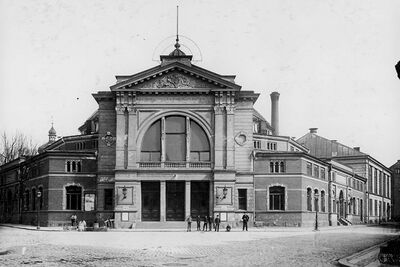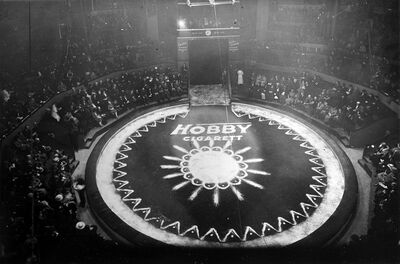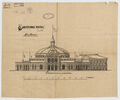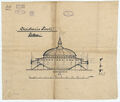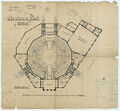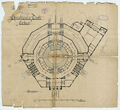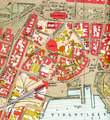Difference between revisions of "Cirkus Verdensteater (Oslo)"
From Circopedia
(→A Polyvalent Venue) |
(→Image Gallery) |
||
| (42 intermediate revisions by the same user not shown) | |||
| Line 4: | Line 4: | ||
[[File:Cirkus_Verdensteater_Christiania.jpg|thumb|left|400px|The Cirkus Verdensteater (c.1905)]]From 1890 to 1935, Oslo, the capital of Norway, housed a magnificent circus building known as the ''Cirkus Verdensteater'' ("Circus World Theater"). It was located at the corner of Klingenberggata and Bakkegaden, in the old Vika neighborhood, and adjacent to the Tivoli Gardens—a part of the city that completely disappeared when this area was demolished and rebuilt in the 1930s. The circus stood approximately where the Klingenberg movie theater is now, in the middle of the present Olav V Gate. | [[File:Cirkus_Verdensteater_Christiania.jpg|thumb|left|400px|The Cirkus Verdensteater (c.1905)]]From 1890 to 1935, Oslo, the capital of Norway, housed a magnificent circus building known as the ''Cirkus Verdensteater'' ("Circus World Theater"). It was located at the corner of Klingenberggata and Bakkegaden, in the old Vika neighborhood, and adjacent to the Tivoli Gardens—a part of the city that completely disappeared when this area was demolished and rebuilt in the 1930s. The circus stood approximately where the Klingenberg movie theater is now, in the middle of the present Olav V Gate. | ||
| − | At the time of the circus's construction, the city was still called Kristiania (it will become Oslo in 1925), and the circus was known originally as ''Cirkusbygningen i Kristiania'' ("Kristiania's circus building"). It was built by a Danish businessman named Bernhard Holger Jacobsen (1866-1933), who had purchased the piece of land on which the Tivoli Gardens stood in 1887. The Tivoli Gardens were a place of entertainment with, among other attractions, a restaurant and a small theater. | + | At the time of the circus's construction, the city was still called Kristiania, or Christiania (it will become Oslo in 1925), and the circus was known originally as ''Cirkusbygningen i Kristiania'' ("Kristiania's circus building"). It was built by a Danish businessman named Bernhard Holger Jacobsen (1866-1933), who had purchased the piece of land on which the Tivoli Gardens stood in 1887. The Tivoli Gardens were a place of entertainment with, among other attractions, a restaurant, a cabaret called ''Le Chat Noir'' (after Paris's famous cabaret in Montmartre), and a small theater. The Gardens also welcomed visiting circuses in various wooden structures, and Jacobsen thought building a large permanent circus there would be a good business move. |
| − | The architect he chose was Ove Laurentius Ekman (1847-1921), who had designed several buildings in | + | The architect he chose was Ove Laurentius Ekman (1847-1921), who had designed several buildings in Kristiania, none of which of great significance: The Cirkusbygningen was to be his now-vanished masterpiece. It was a massive structure of red brick with a monumental stone façade, in the Neo-Renaissance style fashionable at the time, which opened on a vast foyer. The entire building occupied a total surface of 3,200 square meters (3,827 square yards). The house itself was 40 meters in diameter (131.23 feet), with a cupola that culminated at 32 meters (105 feet). |
| − | + | It could accommodate 2,200 spectators, with four rows of seats around the ring and a row of boxes just behind them, and a third category with six rows of seats on the upper level divided in two categories, and a ''promenoir'' (standing room gallery) on two levels. The circus had a metallic infrastructure, with metallic columns that supported the cupola on the periphery behind the boxes. The orchestra was positioned above the ring entrance, with a large "royal box" facing it. The rest of the building housed stables for sixty horses (under the seating in the periphery of the house), storage rooms, dressing rooms for the performers, and offices for the administration. Heated with hot air and equipped with electric lighting, it was quite state-of-the-art for its time. The total cost of the construction amounted to 300,000 kronen, quite a significant amount in 1890. | |
| − | ===A | + | ===A Multivalent Venue=== |
| − | + | Holger Jacobsen, who owned the Tivoli Gardens and the circus until 1897, was not himself a showman, and the Cirkusbygningen had been built principally to accommodate independent, often foreign, circus companies visiting Oslo. It opened with great fanfare on March 15, 1890, with Gothold Schumann's renowned [[Cirkus Schumann]], which was then based in Sweden and had often shown in Oslo. Gothold's son and successor, [[The Schumann Dynasty|Max]], and Max's sons and grandsons, would bring Cirkus Schumann again to Oslo the three following years, and another time in 1896. The demolition of the building to make place for the new Vika neighborhood happened in 1935: closing a chapter it had opened, Cirkus Schumann returned to Oslo that year, the last circus to perform in the building—after a long hiatus when it had been used for other purposes. | |
| − | + | [[File:Interior_-_Cirkus_Verdensteater.jpg|thumb|right|400px|Cirkus Schumann at the Cirkus Verdensteater (1935)]]Since it had no permanent company, the circus quickly became a multivalent performing space, hosting activities that were not necessarily related to its original function (thus its later name, ''Cirkus Verdensteater''): In 1896, for instance, it presented the first cinema performance in Norway, and will be used as a movie theater quite often, notably in its latter years. It became also well-known and appreciated for its music concerts—and its own resident orchestra had been led by such guest conductors as the celebrated Norwegian composers Johan Svendsen (1840–1911) and Edvard Grieg (1843–1907). | |
| − | + | Nonetheless, visiting circuses still performed in the building. Besides Cirkus Schumann, the Cirkus Verdensteater hosted, over the years, [[Circus Corty-Althoff]], [[Cirkus Kolzer]], [[Circus Beketov]], William Caspar's [[Cirque du Nord]], [[Circus Carré]], [[Circus Ed. Wulff]], [[The Houcke Dynasty|Hippolyte Houcke]]'s ''Nouveau Cirque'', [[Cirkus Orlando]], Andrea Ciniselli's [[Circus Ciniselli]], among others, and [[Circus Hagenbeck]] in 1916—the last tenant before a long hiatus that will be broken only with the final return of the Schumanns in 1935. | |
| − | + | Unfortunately, Vika, the part of the city in which the circus stood was quite ancient and in need of remodeling. When it was decided in 1916 that a new City Hall would be built in that neighborhood, the old, sometimes dilapidated buildings that still stood in the area had to disappear to allow a modern redesign of the district. The Tivoli Gardens and the Cirkus Verdensteater were for some time the last remnants of the old neighborhood, until they were eventually demolished in 1935, never to be replaced. | |
| − | + | ||
| − | Unfortunately, Vika, the part of the city in which the circus stood was quite ancient and in need of remodeling. When it was decided in 1916 that a new City Hall would be built in | + | |
==Suggested Reading== | ==Suggested Reading== | ||
| Line 29: | Line 27: | ||
<Gallery> | <Gallery> | ||
| + | File:Oslo_Cirkus_elevation.jpg|Ekman's rendering of the circus building (c.1889) | ||
| + | File:Oslo_Circus_cross_section.jpg|Ekman's cross-section of the circus building (c.1889) | ||
| + | File:Oslo_Circus_Plan.jpg|Ekman's house plan of the circus building (c.1889) | ||
| + | File:Oslo_Circus_floor_plan.jpg|Ekman's floor plan of the circus building (c.1889) | ||
| + | File:Oslo_Cirkus_infrastructure.jpg|Ekman's detail of the circus building's metallic infrastructure (c.1889) | ||
| + | File:Bernhard_Holger_Jacobsen.png|Bernhard Holger Jacobsen (1890) | ||
File:Ove_Ekman_portrait.jpg|Ove Ekman (1898) | File:Ove_Ekman_portrait.jpg|Ove Ekman (1898) | ||
| + | File:Cirkus_and_Tivoli_in_Oslo.jpg|Tivoli Gardens and the circus building (1900) | ||
File:Oslo_Cirkus_map.png|Map showing the Cirkus Vardensteater in Kristiania (1902) | File:Oslo_Cirkus_map.png|Map showing the Cirkus Vardensteater in Kristiania (1902) | ||
| − | File:Cirkus_Verdensteater_Christiania.jpg|Cirkus Vardensteater in | + | File:Oslo_Cirkus_modern_map.png|Map showing the old emplacement of the Cirkus Vardensteater in today's Oslo. |
| − | File:Schumann_Oslo.jpg|Cirkus Schumann at the Cirkus Vardensteater ( | + | File:Cirkus_Verdensteater_Christiania.jpg|Cirkus Vardensteater in Kristiania (c.1905) |
| + | File:Orlando_Tigers_in_Oslo.jpg|Cirkus Orlando's tiger act at Cirkus Vardensteater (1908) | ||
| + | File:Tivoli_%2B_Cirkus_Oslo.jpg|Oslo's Tivoli Gardens (c.1910) | ||
| + | File:Oslo_Cirkus_Verdensteater.png|Cirkus Verdensteater (c.1930) | ||
| + | File:Oslo_Cirkus_and_Tivoli.jpg|The Tivoli and the circus in their final years (1930) | ||
| + | File:Oslo_Circus_(1933).jpg|Side view, Cirkus Verdensteater (1933) | ||
| + | File:Schumann_Oslo.jpg|Cirkus Schumann at the Cirkus Vardensteater (1935) | ||
| + | File:Cirkus_Verdensteater_-_Oslo.jpg|Cirkus Schumann at the Cirkus Vardensteater (1935) | ||
File:Interior_-_Cirkus_Verdensteater.jpg|Last performance of Cirkus Schumann at the Cirkus Verdensteater (1935) | File:Interior_-_Cirkus_Verdensteater.jpg|Last performance of Cirkus Schumann at the Cirkus Verdensteater (1935) | ||
| + | File:Oslo_Circus_demolition.jpg|Cirkus Verdensteater demolition (1935) | ||
</Gallery> | </Gallery> | ||
[[Category:Circuses|Cirkus Verdensteater (Oslo)]] | [[Category:Circuses|Cirkus Verdensteater (Oslo)]] | ||
Latest revision as of 19:42, 27 September 2025
By Dominique Jando
At the time of the circus's construction(French) A temporary circus building, originally made of wood and canvas, and later, of steel elements supporting a canvas top and wooden wall. Also known as a "semi-construction.", the city was still called Kristiania, or Christiania (it will become Oslo in 1925), and the circus was known originally as Cirkusbygningen i Kristiania ("Kristiania's circus building"). It was built by a Danish businessman named Bernhard Holger Jacobsen (1866-1933), who had purchased the piece of land on which the Tivoli Gardens stood in 1887. The Tivoli Gardens were a place of entertainment with, among other attractions, a restaurant, a cabaret called Le Chat Noir (after Paris's famous cabaret in Montmartre), and a small theater. The Gardens also welcomed visiting circuses in various wooden structures, and Jacobsen thought building a large permanent circus there would be a good business move.
The architect he chose was Ove Laurentius Ekman (1847-1921), who had designed several buildings in Kristiania, none of which of great significance: The Cirkusbygningen was to be his now-vanished masterpiece. It was a massive structure of red brick with a monumental stone façade, in the Neo-Renaissance style fashionable at the time, which opened on a vast foyer. The entire building occupied a total surface of 3,200 square meters (3,827 square yards). The house itself was 40 meters in diameter (131.23 feet), with a cupola that culminated at 32 meters (105 feet).
It could accommodate 2,200 spectators, with four rows of seats around the ring and a row of boxes just behind them, and a third category with six rows of seats on the upper level divided in two categories, and a promenoir (standing room gallery) on two levels. The circus had a metallic infrastructure, with metallic columns that supported the cupola on the periphery behind the boxes. The orchestra was positioned above the ring entrance, with a large "royal box" facing it. The rest of the building housed stables for sixty horses (under the seating in the periphery of the house), storage rooms, dressing rooms for the performers, and offices for the administration. Heated with hot air and equipped with electric lighting, it was quite state-of-the-art for its time. The total cost of the construction(French) A temporary circus building, originally made of wood and canvas, and later, of steel elements supporting a canvas top and wooden wall. Also known as a "semi-construction." amounted to 300,000 kronen, quite a significant amount in 1890.
A Multivalent Venue
Holger Jacobsen, who owned the Tivoli Gardens and the circus until 1897, was not himself a showman, and the Cirkusbygningen had been built principally to accommodate independent, often foreign, circus companies visiting Oslo. It opened with great fanfare on March 15, 1890, with Gothold Schumann's renowned Cirkus Schumann, which was then based in Sweden and had often shown in Oslo. Gothold's son and successor, Max, and Max's sons and grandsons, would bring Cirkus Schumann again to Oslo the three following years, and another time in 1896. The demolition of the building to make place for the new Vika neighborhood happened in 1935: closing a chapter it had opened, Cirkus Schumann returned to Oslo that year, the last circus to perform in the building—after a long hiatus when it had been used for other purposes.
Since it had no permanent company, the circus quickly became a multivalent performing space, hosting activities that were not necessarily related to its original function (thus its later name, Cirkus Verdensteater): In 1896, for instance, it presented the first cinema performance in Norway, and will be used as a movie theater quite often, notably in its latter years. It became also well-known and appreciated for its music concerts—and its own resident orchestra had been led by such guest conductors as the celebrated Norwegian composers Johan Svendsen (1840–1911) and Edvard Grieg (1843–1907).Nonetheless, visiting circuses still performed in the building. Besides Cirkus Schumann, the Cirkus Verdensteater hosted, over the years, Circus Corty-Althoff, Cirkus Kolzer, Circus Beketov, William Caspar's Cirque du Nord, Circus Carré, Circus Ed. Wulff, Hippolyte Houcke's Nouveau Cirque, Cirkus Orlando, Andrea Ciniselli's Circus Ciniselli, among others, and Circus Hagenbeck in 1916—the last tenant before a long hiatus that will be broken only with the final return of the Schumanns in 1935.
Unfortunately, Vika, the part of the city in which the circus stood was quite ancient and in need of remodeling. When it was decided in 1916 that a new City Hall would be built in that neighborhood, the old, sometimes dilapidated buildings that still stood in the area had to disappear to allow a modern redesign of the district. The Tivoli Gardens and the Cirkus Verdensteater were for some time the last remnants of the old neighborhood, until they were eventually demolished in 1935, never to be replaced.
Suggested Reading
- Geir Støre, Kristiania tivoli & cirkus (Oslo, Brød & Cirkus, 2021) — ISBN 978-82-303-4913-7
